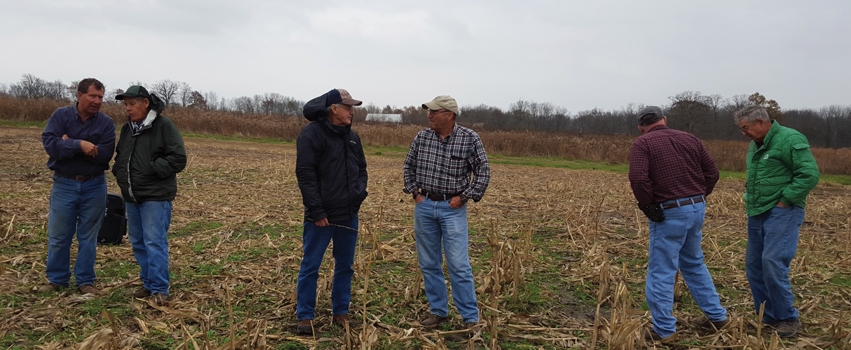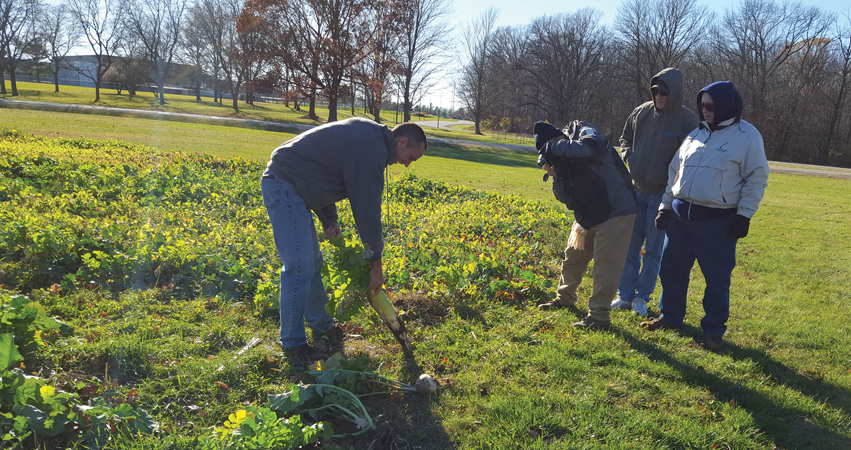
An unlikely group of partners are in alignment about the importance of protecting our lands and waters.
You might not expect a conservationist like me to attend a meeting with representatives from Bunge, Kellogg’s and Pepsi. But this February, I did just that. Members of local soil and water conservation districts were there, too, as were about 40 Illinois farmers. Together, we dug into an important issue that affects us all: soil health.
The attendees represented every link in the supply chain that brings food from the farm to the table. For them, and for me and my colleagues at The Nature Conservancy, this subject is top of mind. Here in the Prairie State, our rich soils have made us the nation’s third largest producer of agricultural commodities. Today, the Illinois food and fiber industry also employs nearly one million people, and the state exports $8.2 billion worth of soybeans, feed grain and agricultural products to other countries.
But our rich soils are in trouble, as use of the land to produce the food the world needs has impacted soil health and the important organisms that call it home. Soil is a living natural resource, comprised of billions of fungi, earthworms, bacteria and other microorganisms that help plants grow, absorb nutrients and fight off pests. In fact, there are more microorganisms in a teaspoon of healthy soil than there are people on the earth. And they all play a role in giving us the rich crops that power local economies and provide the food so many rely on.
Building Partnerships
To ensure the health of our soils, members of the agricultural community and the agricultural supply chain are joining together with state and federal agencies and conservation groups to tackle this issue head on.
The members of the Illinois Sustainable Ag Partnership, for example, have come together to build on the momentum around soil health, cover crops, water quality, nutrient management and conservation issues. Members include The Nature Conservancy, American Farmland Trust, Illinois Corn Growers Association, Illinois Central College, Precision Conservation Management, Soil Health Partnership, The Wetlands Initiative and The Zea Mays Foundation. As a coordinated and consistent group, they are focused on messaging, outreach, training and education for farmers and their trusted advisors, as well as creating a network of on-farm demonstration sites to bring together and disseminate new information and lessons learned in plain, practical language specifically designed to reach the more hesitant middle adopters.
The Midwest Row Crop Collaborative (MRCC) is a broad-based effort to support, enhance and accelerate the use of sustainable agricultural practices already underway in Illinois, Iowa and Nebraska. The MRCC unites the collective reach, experience and scientific expertise of Cargill, Environmental Defense Fund, General Mills, Kellogg Company, Land O’Lakes, McDonald’s, Monsanto, PepsiCo, The Nature Conservancy, Unilever, Walmart and the World Wildlife Fund. The Soil Health Partnership is another good example. This farmer-led initiative of the National Corn Growers Association is focused on finding the best ways to measure soil health. It’s supported by the Conservancy, Environmental Defense Fund, Natural Resources Conservation Service, Monsanto, The Walton Family Foundation, Midwest Row Crop Collaborative and The General Mills Foundation.

Farmers and advisors examine in-field cover crop growth coming up in corn residue as part of a cover crop management training session.
Sustainable Farming Practices
These partnerships couldn’t come at a better time. Currently, the United States is losing 10 billion tons of fertile soil every year due to erosion and other factors, much faster than the rate nature can replenish it. And the demand on our lands to produce is only growing—the world needs a substantial increase in agricultural production by 2050 to feed the 10 billion people who will inhabit the planet.
Additionally, the need for soil health extends well beyond farmland. Healthy soil is crucial for clean water, as it absorbs and holds water during storm events and is less likely to wash off farm fields into our rivers and lakes. Healthy soils that contain more organic matter also store more carbon and help mitigate the effects of climate change. Therefore, the challenges we face today not only pose threats to local economies, but local ecologies as well.
The good news is that sustainable farming practices such as no-till, cover crops and crop rotations can vastly improve soil health—as well as landowners’ bottom lines. These practices protect the microorganisms in healthy soil and even promote their growth, all while keeping soil where it belongs: on the farm. The result is a more productive, resilient asset for farmers as well as the consumers who are concerned about sustainably grown crops.
The benefits don’t stop at the farm, though. The implementation of these practices could have an incredible impact on Illinois’ agricultural economy, as well as other states across the country. A soil health roadmap, prepared by an interdisciplinary team of Nature Conservancy scientists, environmental economists and agricultural experts, outlines how adopting soil health practices on all U.S. corn, soy and wheat croplands could deliver nearly $50 billion in social and environmental impacts annually.
For conservation groups like The Nature Conservancy, sustainable farming offers big benefits for nature, too. Take, for example, our work in the Upper Sangamon River watershed. For 246 miles, the main stem of the Sangamon River winds its way through central Illinois before it joins the Illinois River. The river’s abundant fish and wildlife, along with the rich soils nearby, provided early civilizations with food and fresh water. Eventually, much of the land was converted into agriculture.
Today, the river suffers from high levels of sediment and nutrients, which wash off nearby farm fields and escape through underground drains during storms. They impact water quality in the river, affecting both fish and wildlife habitat, as well as local drinking water supplies. Additionally, as excess nutrients enter the Illinois River from the Sangamon, they eventually flow into the Mississippi River and the Gulf of Mexico, where they cause harmful algal blooms that contribute to the Gulf’s “Dead Zone.”
Across the watershed, Conservancy scientists are collaborating with farmers who are leading the charge for change. Ultimately, sustainable farming collaborations in the Upper Sangamon River watershed are intended to be replicated across the state. In addition, farmers’ efforts will help Illinois meet the goals in its Nutrient Loss Reduction Strategy, which is to reduce the annual contribution of nutrients to the Mississippi River by 45 percent by 2035.

Field day at Illinois Central College
Coordination and Collaboration
With farms covering 75 percent of the state’s total land area, agriculture in Illinois is a complex industry that involves many, from local farmers and crop advisors to supply chain representatives. Meeting improvement goals for soil health and water quality, such as the Nutrient Reduction Loss Strategy, will require coordination and alignment—that’s where partnerships of diverse stakeholders play a key role.
My meeting with Bunge, Kellogg’s, Pepsi and others reflects this movement towards coordination and collaboration on the issue of soil health. It’s a big job to do, but I already see signs of change. At that February meeting, what amazed me the most was that everyone who spoke was basically saying the same thing. We are all in alignment about the importance of protecting our lands and waters for both nature and people. We may be an unlikely group of partners, but together, we are going down the right path. iBi
Caroline Wade is Director of Agriculture for The Nature Conservancy in Illinois.

